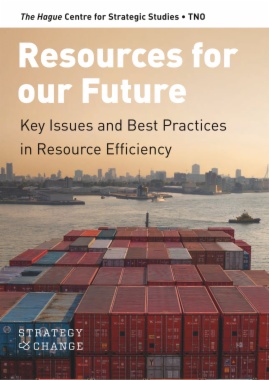Compiling years of research into the geopolitical, economic, and ecological dimensions of material scarcity and resource efficiency, Resources for our Future provides a concise analysis of international resource efficiency. Offering an inspiring account of industrial best practices, the editors have put together a broad range of case studies, which focus on the chemical, textile, and food industries.
- Contents
- Foreword
- Management summary
- 1. Introduction
- 1.1 Drivers of resource use
- 1.2 Decoupling
- 1.3 Global dimensions
- 1.4 Key issues and best practices
- 2. Resource constraints
- 2.1 A classification of challenges
- 2.2 Energy resources: security of supply and climate impacts
- 2.3 Water and land: ecological footprint
- 2.4 Abiotic resources: metal ores and industrial minerals
- 2.5 Abiotic resources: construction minerals
- 2.6 Biotic resources: HANPP and biodiversity problems
- 2.7 Linkages and trade-offs
- 2.8 Conclusions
- 3. The geopolitics of resources
- 3.1 International trade flows of natural resources
- 3.2 Price developments
- 3.3 The emerging international system
- 3.4 Policy trends
- 3.5 The EU: challenges and policy responses
- 3.6 The Netherlands
- 3.7 Conclusions
- 4. Resource strategies
- 4.1 Mining primary resources
- 4.2 Process optimization
- 4.3 Materials recycling
- 4.4 Radical redesign of products
- 4.5 Substitution: easier said than done
- 4.6 Intensifying the use of products and services
- 4.7 Shifting expenditures to low-impact products and services
- 4.8 Improving quality of life without spending money
- 4.9 Conclusions
- 5. Resource efficiency in the built environment
- 5.1 Bricks outlive their buildings
- 5.2 Reducing carbon dioxide by reusing secondary materials
- 5.3 No needs to barbecue secondary asphalt
- 5.4 Building a business model on borrowed materials
- 6. Resource efficiency in the food sector
- 6.1 Brewing a better future
- 6.2 Making a business case of sustainability
- 6.3 'Green Deal' turns Holland into net exporter of phosphate
- 6.4 Insects as new raw material and protein source
- 7. Biotic resources in the process industry
- 7.1 Clutching at straws to make paper
- 7.2 Beet thick juice is naphtha to bio-based economy
- 7.3 YXY platform molecule - the green 'Intel Inside'
- 7.4 Sowing the seeds of the third industrial revolution
- 7.5 Waste is culturally defined
- 8. Resource efficiency in the metal and consumer electronics industries
- 8.1 Improving raw material efficiency in the steel industry
- 8.2 Making recycled materials mainstream
- 8.3 Waste management and the circular economy
- 8.4 Sustainability as a driver of innovation
- 9. Resource efficiency in fashion and furnishings
- 9.1 Adding volume to the circular economy
- 9.2 Designed for reincarnation
- 9.3 Sustainability with substance
- 9.4 Dyeing textiles without water
- 10. The challenges ahead
- 10.1 Understanding the challenges
- 10.2 Business opportunities
- 10.3 Creating the necessary conditions
- Acknowledgements
- References
- About the authors

